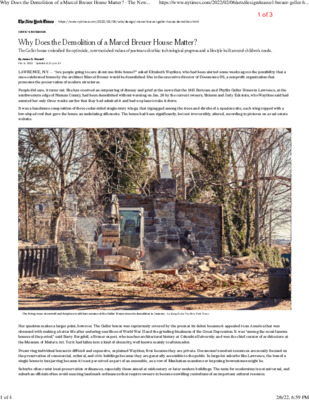B-11 (C14H-2021-0180 - Casa McMath; District 10)_Part3.pdf — original pdf
Backup

Why Does the Demolition of a Marcel Breuer House Matter? - The New... https://www.nytimes.com/2022/02/06/arts/design/marcel-breuer-geller-h... https://www.nytimes.com/2022/02/06/arts/design/marcel-breuer-geller-house-demolition.html Why Does the Demolition of a Marcel Breuer House Matter? The Geller house embodied the optimistic, now-vanished values of postwar suburbia: technological progress and a lifestyle built around children’s needs. CRITIC’S NOTEBOOK By James S. Russell Feb. 6, 2022 Updated 4:21 p.m. ET LAWRENCE, N.Y. — “Are people going to care about one little house?” asked Elizabeth Waytkus, who had been alerted some weeks ago to the possibility that a once-celebrated house by the architect Marcel Breuer would be demolished. She is the executive director of Docomomo US, a nonprofit organization that promotes the preservation of modern structures. People did care, it turns out. She has received an outpouring of dismay and grief at the news that the 1945 Bertram and Phyllis Geller House in Lawrence, at the southwestern edge of Nassau County, had been demolished without warning on Jan. 26 by the current owners, Shimon and Judy Eckstein, who Waytkus said had assured her only three weeks earlier that they had admired it and had no plans to take it down. It was a handsome composition of three cedar-sided single-story wings, that zigzagged among the trees and shrubs of a spacious site, each wing topped with a low-sloped roof that gave the house an undulating silhouette. The house had been significantly, but not irreversibly, altered, according to pictures on a real estate website. The living room stonewall and fireplace is all that remains of the Geller House since its demolition in January. An Rong Xu for The New York Times Her question makes a larger point, however. The Geller house was rapturously covered by the press at its debut because it appealed to an America that was obsessed with making a better life after enduring sacrifices of World War II and the grinding bleakness of the Great Depression. It was “among the most famous houses of the period,” said Barry Bergdoll, a Breuer expert, who teaches architectural history at Columbia University and was the chief curator of architecture at the Museum of Modern Art. Yet it had fallen into a kind of obscurity, well known mainly to aficionados. Preserving individual houses is difficult and expensive, explained Waytkus, first because they are private. Docomomo’s modest resources are mostly focused on the preservation of commercial, cultural, and civic buildings because they are generally accessible to the public. In large-lot suburbs like Lawrence, the loss of a single house is less jarring because it is not perceived as part of an ensemble, as a row of Manhattan mansions or imposing brownstones might be. Suburbs often resist local preservation ordinances, especially those aimed at midcentury or later modern buildings. The taste for modernism is not universal, and suburban officials often avoid enacting landmark ordinances that require owners to become unwilling custodians of an important cultural resource. 1 of 4 2/6/22, 6:59 PM 1 of 3 Marcel Breuer’s Geller House, 1945, was emblematic of the greater informality families sought. But preserving midcentury homes is difficult and expensive.Credit...Ezra Stoller/Esto 2 of 3 Why Does the Demolition of a Marcel Breuer House Matter? - The New... https://www.nytimes.com/2022/02/06/arts/design/marcel-breuer-geller-h... “There aren’t very many tools to aid the preservation of these houses,” Waytkus explained. The best activists can do, she says, is promote the value of postwar architecture to the community, as well as to sellers. Then try to find buyers willing to preserve them. The Marcel Breuer-designed house known as Geller I, after its construction in Lawrence, N.Y., in the mid-1940s. Three cedar-sided single-story wings zigzagged among trees that are now massive. Ezra Stoller/Esto The Geller house received a great deal of attention when it was built because it confidently embodied the new values of suburbia: technological progress, and an informal, unshowy lifestyle built around children, with easy access to outdoor play and relaxation. It is an emblem of a time that has absolutely vanished: when postwar suburbs, at their best, were places of possibility, of innovation and new ideas. The architecture of single-family houses expressed those aspirations and embodied that emerging lifestyle. The Geller house was described as binuclear, a rather self-important way to underscore the primacy of child rearing that informed the design. The visitor entered an enclosed breezeway that separated wings for family activities from a bedroom wing. Two of the children’s bedrooms faced a playroom that ran the full width of that wing, which opened directly to a lawn for outdoor recreation. On the other side of the breezeway, the kitchen, dining and living areas flowed into each other in a relaxed manner — emblematic of the greater informality families sought. The owners did not treat the house as a showpiece. Joe Geller, one of the Geller’s four boys, told Caroline Rob Zaleski, the author of “Long Island Modernism: 1930-1980,” that his mother “didn’t mind us as young children running indoors to outdoors, and from room to room with all our friends.” The upward sloping roofs in both wings conferred a generosity to the rooms’ modest dimensions, as did extensive floor-to-ceiling window walls that splashed sunlight across the flagstone floors and opened to the greenery outside. Marcel Breuer, born in 1902, made his way from Hungary to study in Vienna, then entered the Bauhaus school at Dessau, Germany, where he would later run the furniture studio. He designed two celebrated chairs, the Cesca and the Wassily — both were framed in chromed tubular steel and succinctly captured the Bauhaus synthesis of abstract geometries and industrial techniques. 2 of 4 2/6/22, 6:59 PM 3 of 3